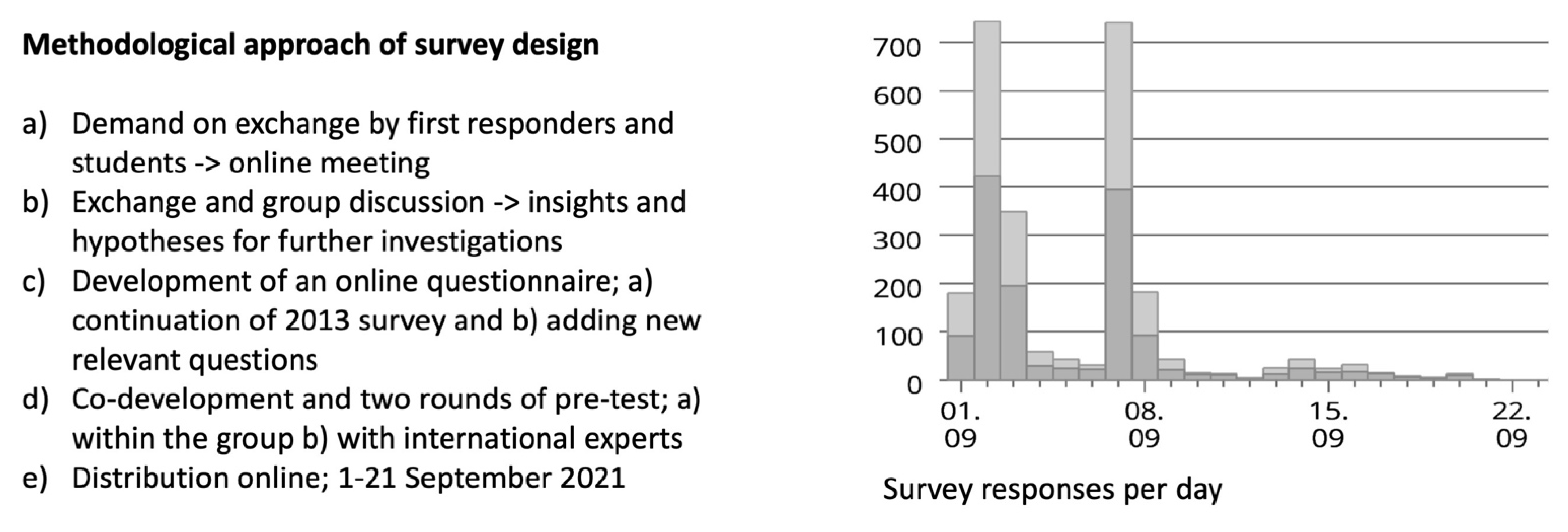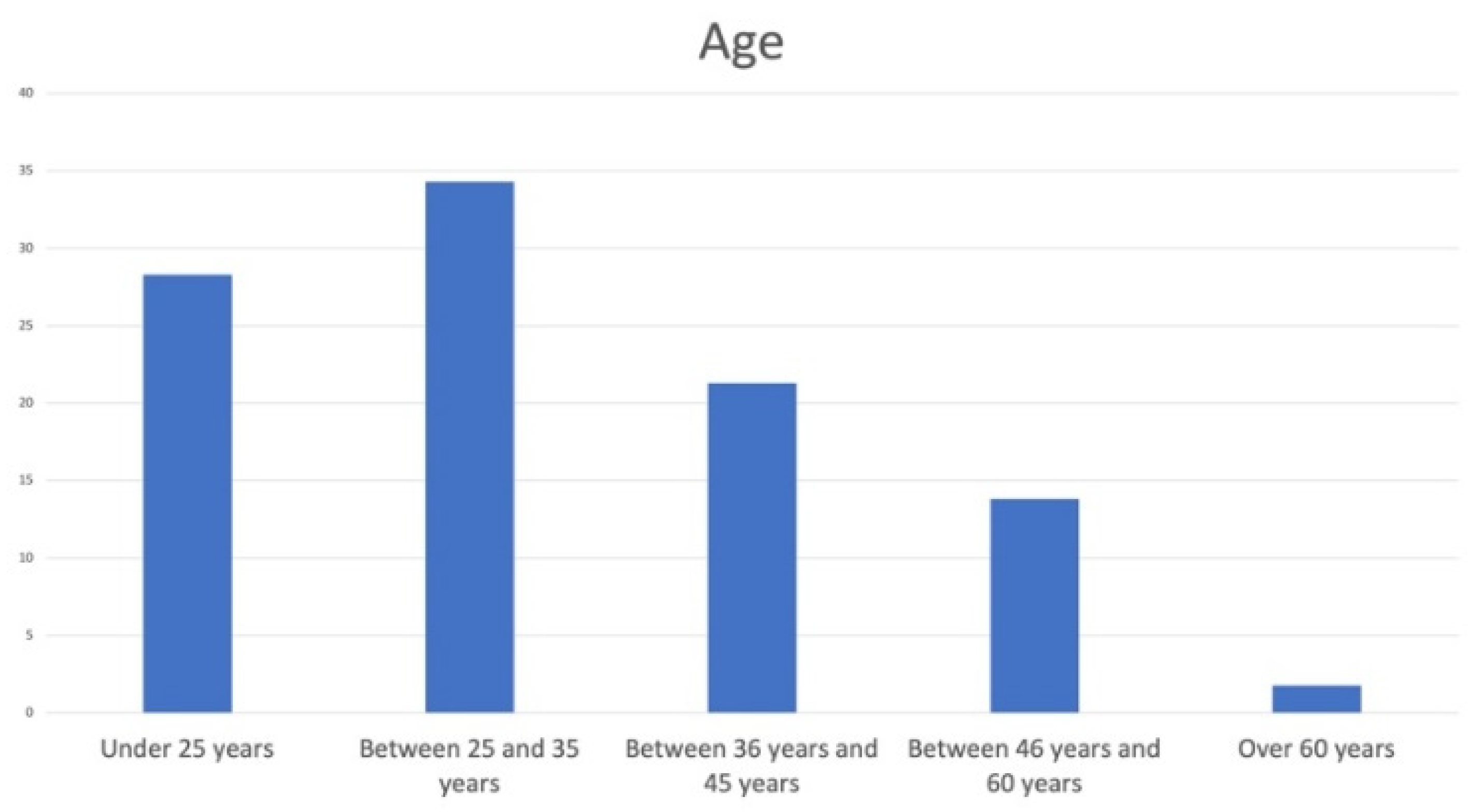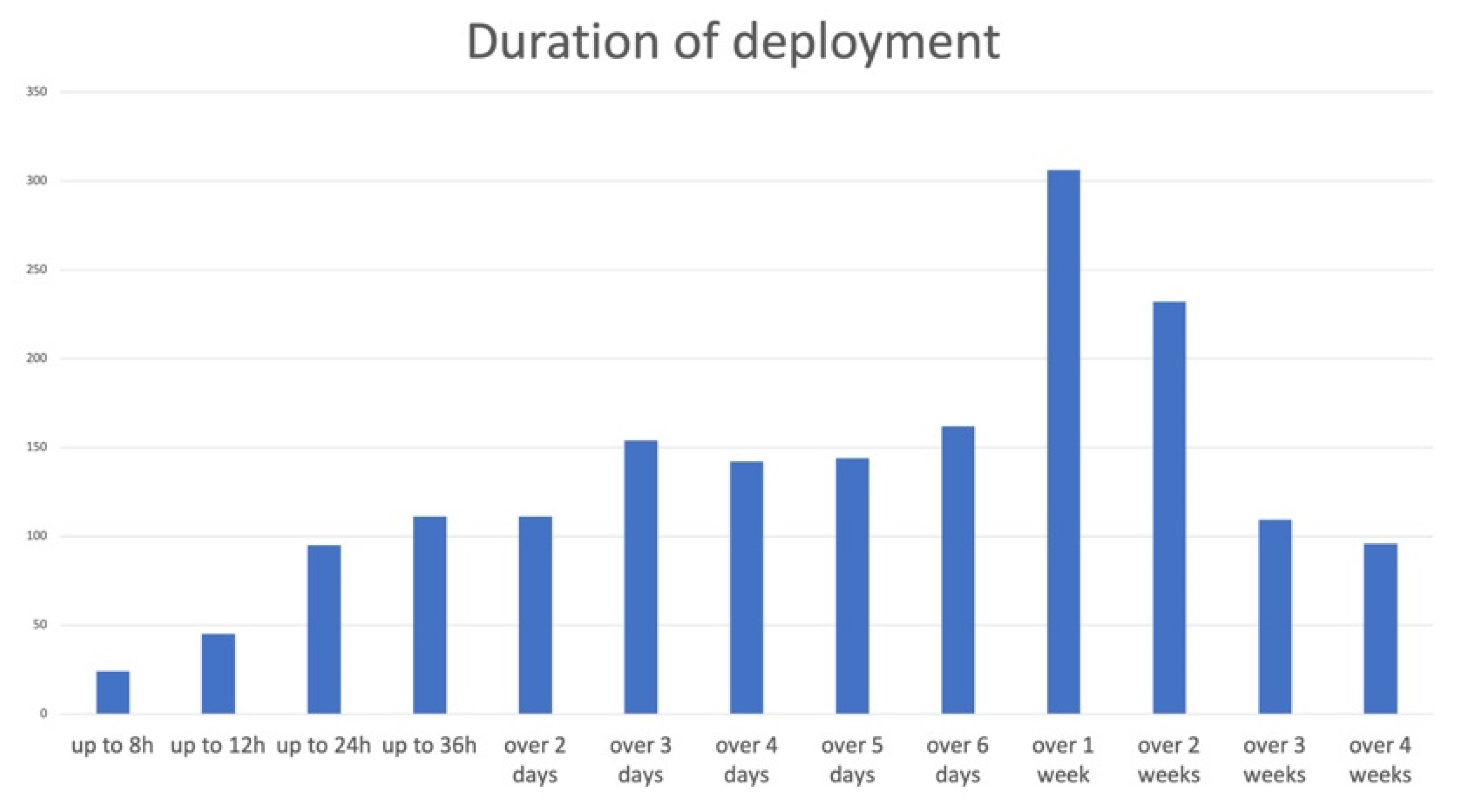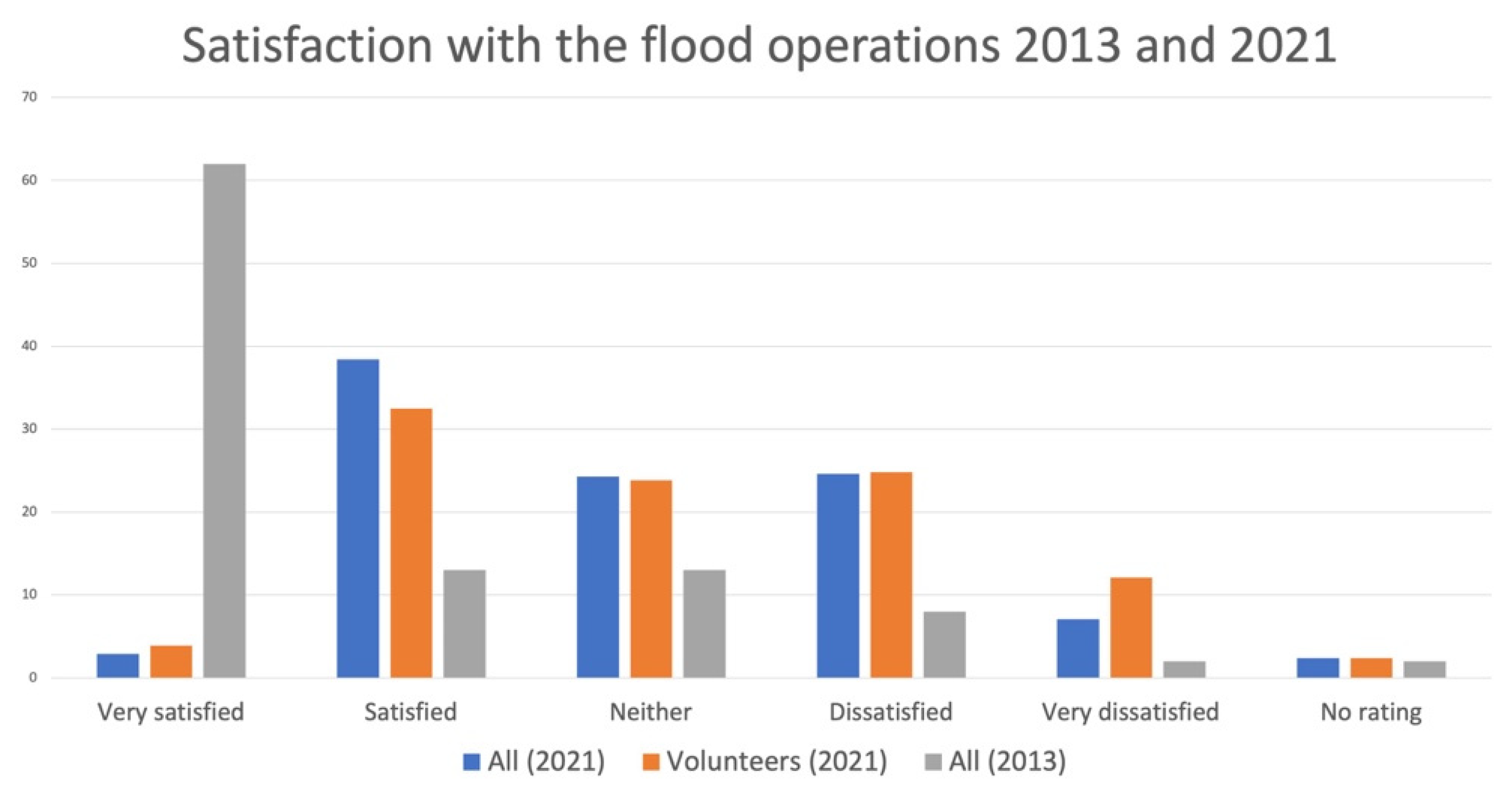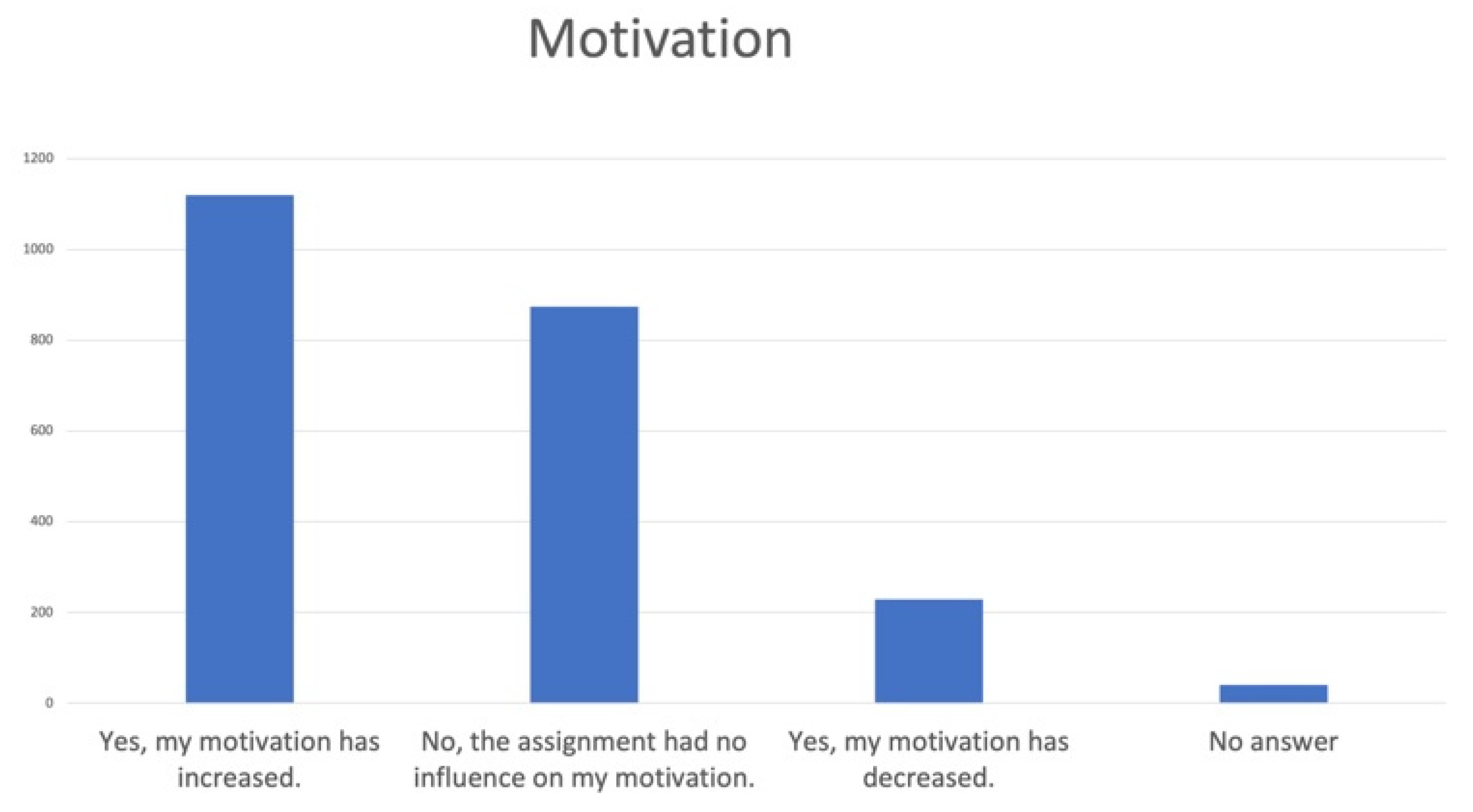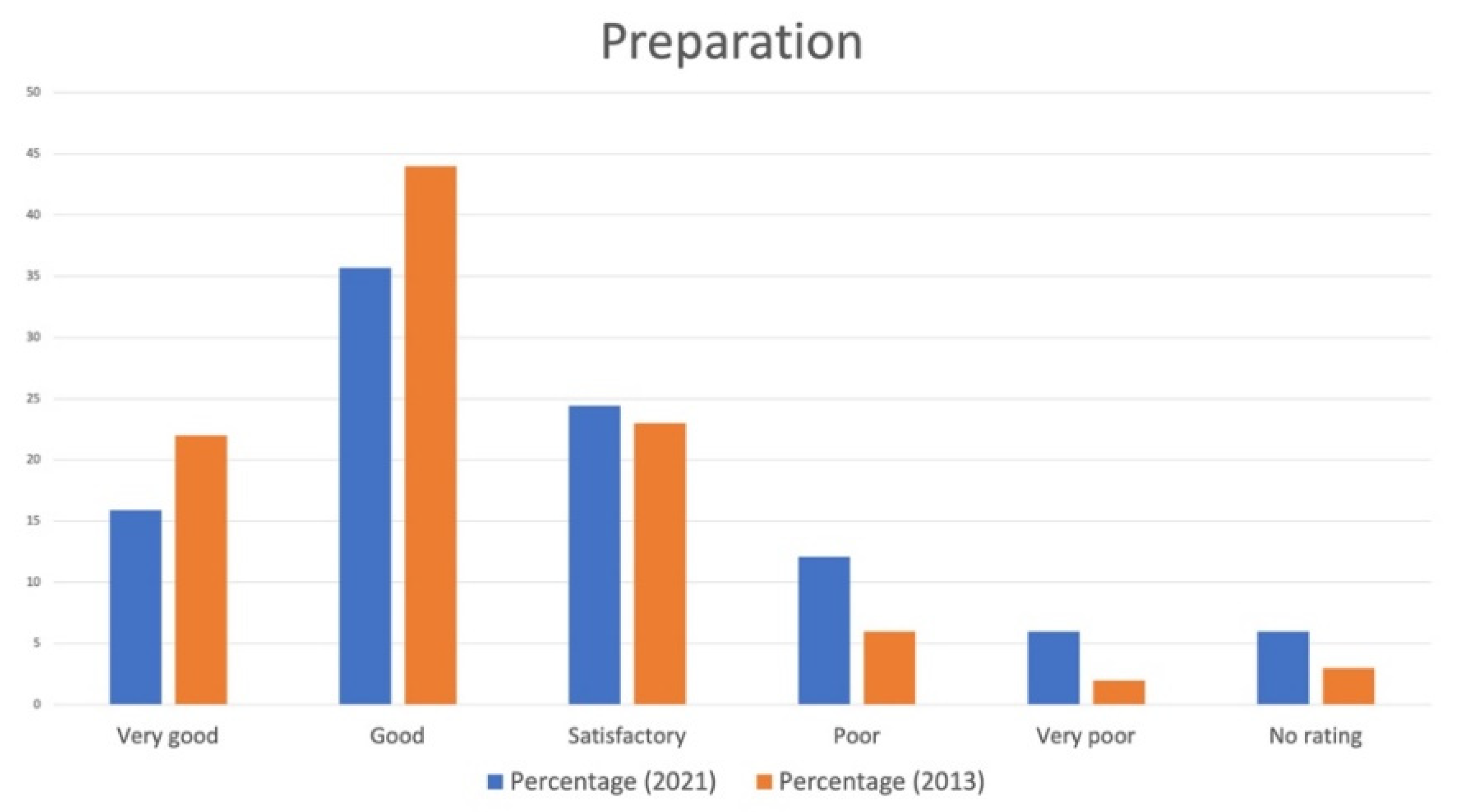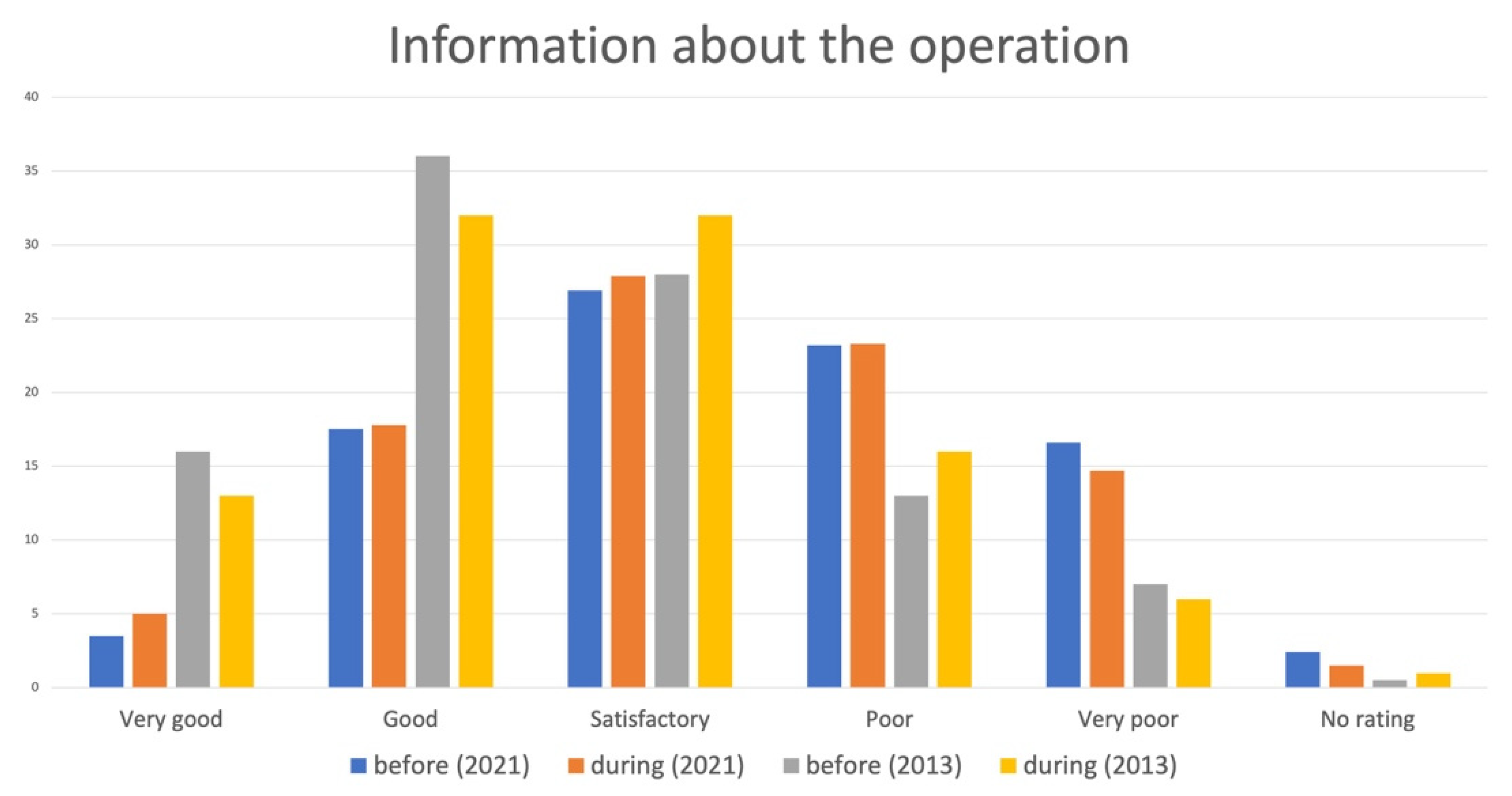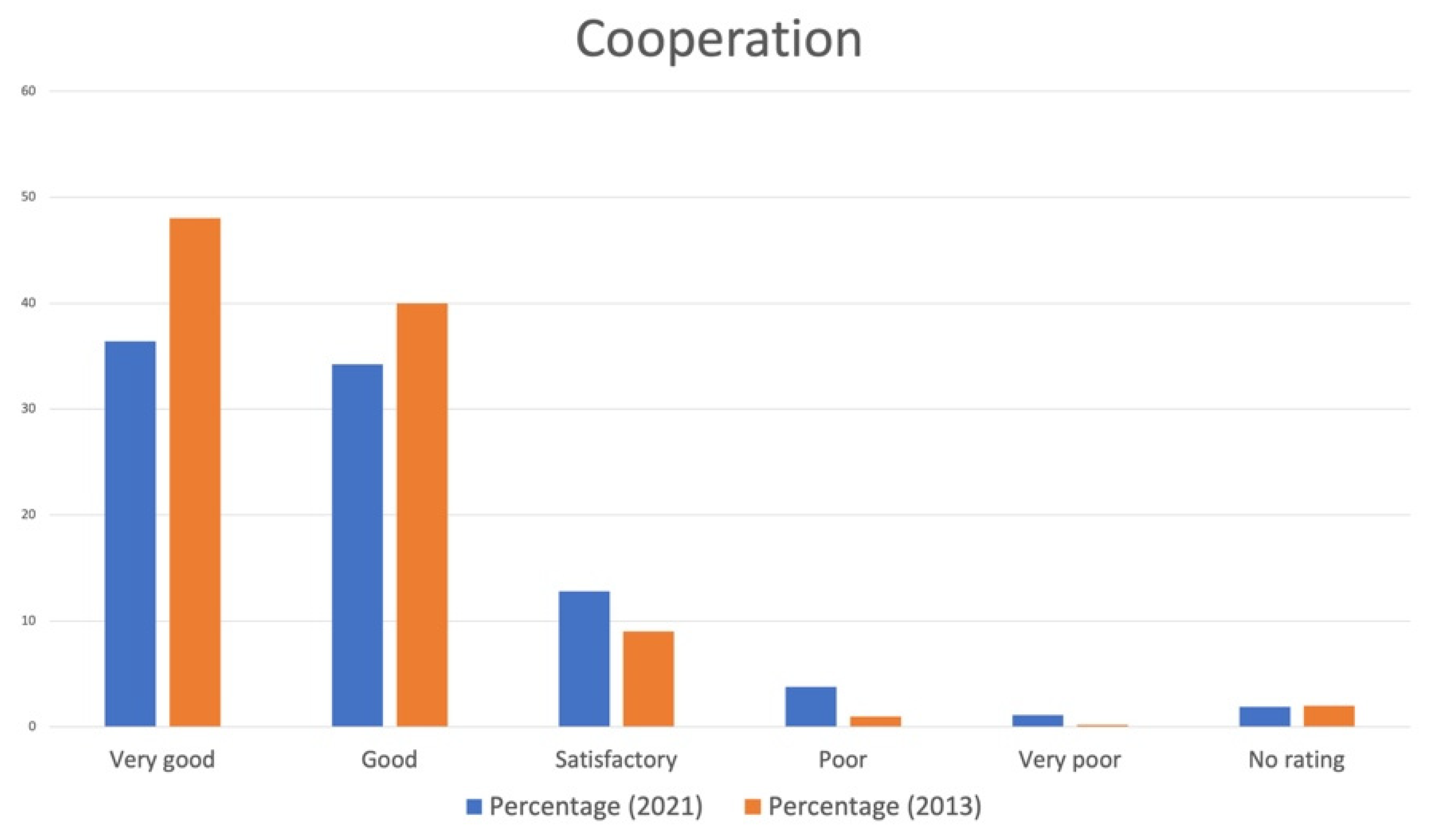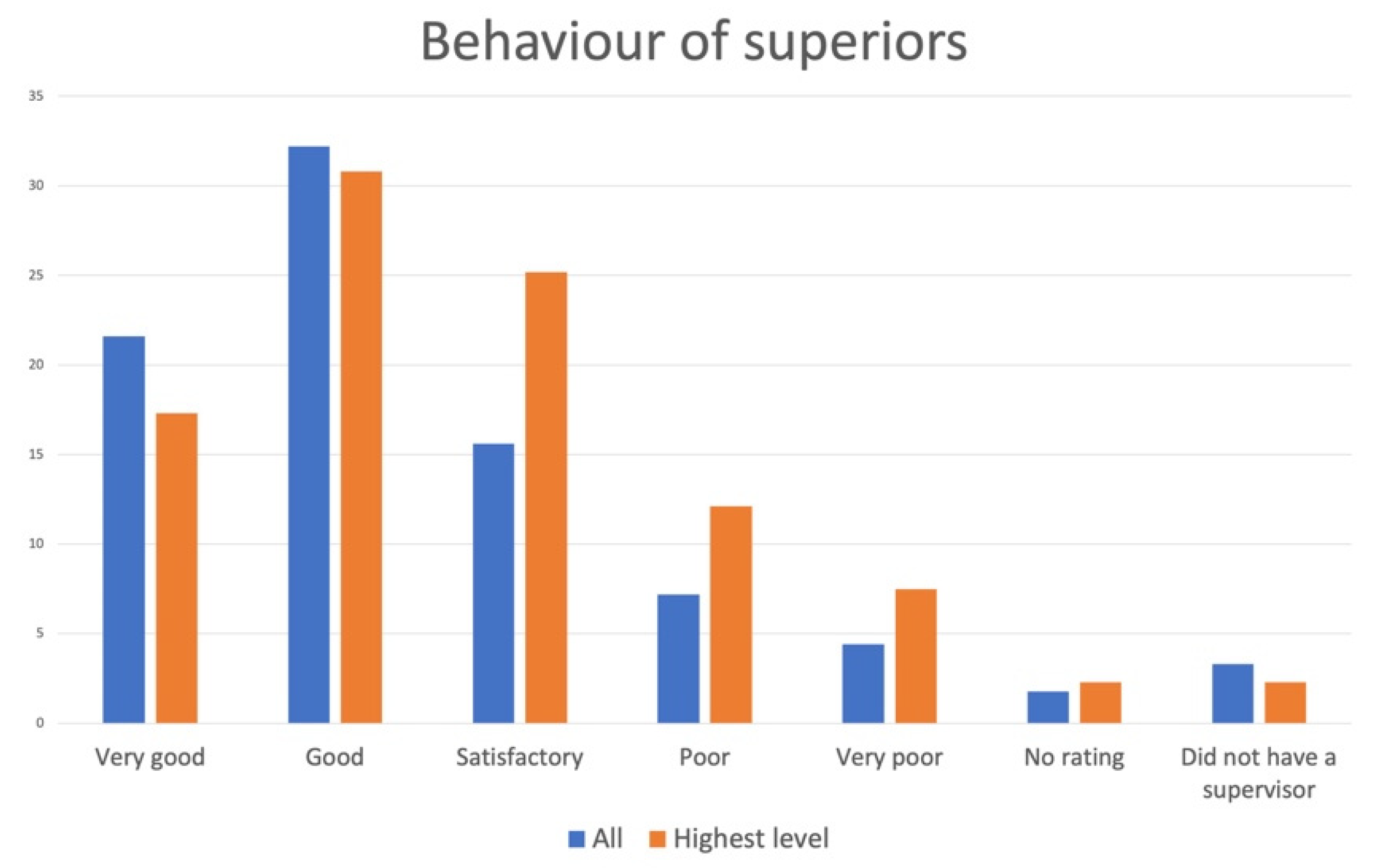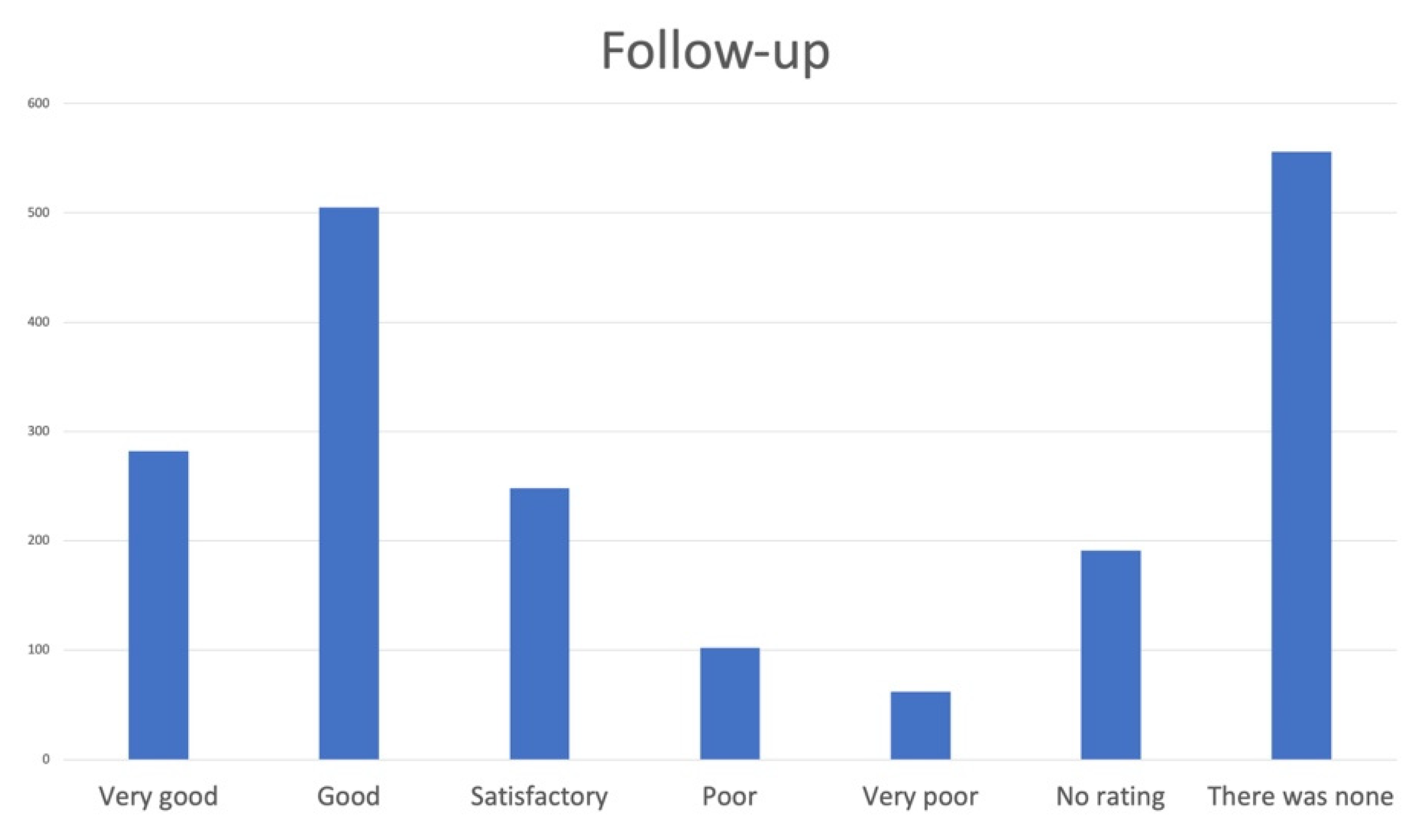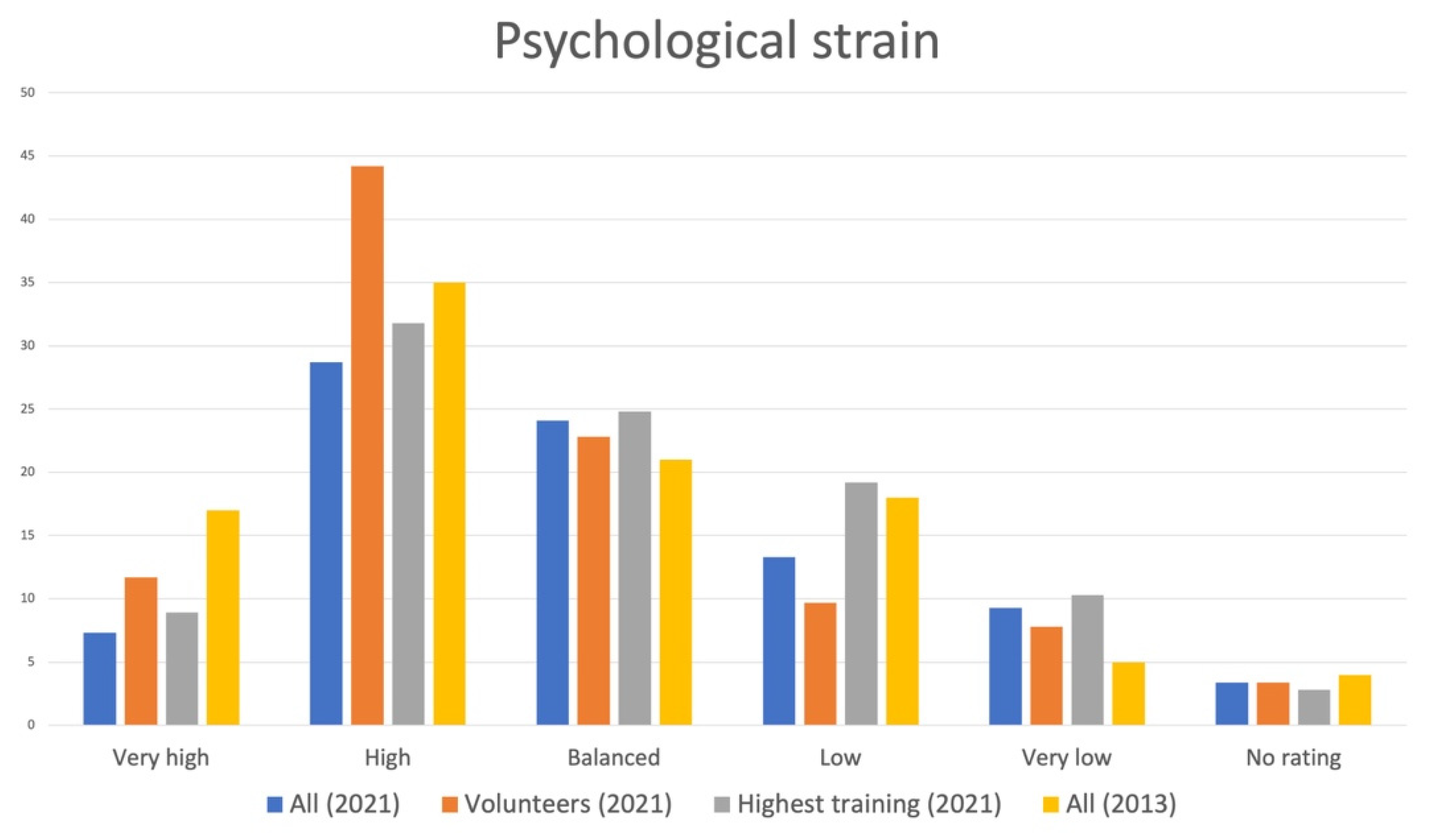1. Introduction
The floods along riverine areas triggered by heavy rains in Europe resulted in amounts of death tolls and damages [
1] not experienced in Germany in recent times since 1962. While riverine floods are rather common, and smaller pluvial floods have occurred in recent years more frequently, pluvial flood damages in this range were uncommon. But especially, the high death toll in an industrialised country that had not seen such high numbers and damages has been perceived as a surprise and shock [
2]. Similar to other flood disasters elsewhere, the public debate soon started on questions of responsibility and guilt [
3]. Crisis management came under critique from the media and the public [
4,
5].
Crisis management is used as an umbrella term in this article for related areas of disaster management, disaster response, or emergency management. In the context of German civil protection, crisis management is used for the phase of the disaster unfolding, while risk management is used for the phase of preparedness [
6].
There have been many lessons-learned studies worldwide and in Germany after major flood events in 1993, 1995, 1997, 2002, 2006, and 2013 [
7,
8,
9,
10,
11]. The topic of voluntary helpers is an international research topic regarding motivation and composition concerning age and values [
12]. It became a topic of research in Germany, especially after the floods in 2013 [
13,
14]. However, the perspective of needs and motivations of official emergency personnel has hardly been addressed by empirical studies in Germany so far. Many studies exist on risks and disasters worldwide, but since this article is about a survey in Germany, it mainly focuses on German research.
Research on floods in Germany address hazard as well as impact, vulnerability, and resilience aspects. Forensic disaster assessments capture the flood triggers and key damages [
15]. Research on floods about motivation and perception considers cross-sectional aspects, and some studies begin comparisons between different flood events [
16]. Lessons-learned studies recurrently address shortcomings in risk management, coordination, and communication, for instance, for the significant flood events of 2002, 2013, and 2021 [
7,
8,
17].
People affected are analysed regarding their preparedness, household damages [
17,
18], perception towards flood risk and capacities [
19,
20], or recovery [
21]. There is increasing research about a shift towards governance and a greater role for citizens in flood risk management and flood resilience [
22,
23,
24], especially within the area of risk perception and social vulnerability [
24] or community resilience [
25,
26]. This is also an emerging topic in semi-quantitative studies and modelling [
27]. Psychological aspects about perceptions of risks are addressed by German researchers [
20,
28] as well as motivational aspects [
29,
30], but these need more investigations together with operational and disaster risk reduction aspects to form a more comprehensive view on risk-informed decision making [
31]. An emerging topic in research in Germany is the integration of spontaneous or volunteer helpers into flood risk management [
32,
33]. There is an interest in using digital platforms to enable such integration [
13] better. There are few studies about the operational organisations or people involved in them, but many on the overall flood risk governance approach [
34,
35] exist. This study addresses the operational forces and helpers as a stakeholder group concerning their perceptions of problems and capacities. Similar approaches have focused mainly on affected people, with similar survey approaches and sample sizes [
16].
Germany has been hit by flood events recurringly, and the events from 2013 and 2021 were the major events in the past decade regarding flood extent and damage. The 2013 flood was a riverine flood triggered by rainfall between 30 May and 3 June 2013 and has affected areas in 12 out of 16 of the German federal states as well as in other neighbouring countries, too. Precipitation sums reached over 200 mm. Fourteen casualties were reported, and damages reached 8 billion € [
36].
The 2021 flood was triggered by heavy rainfall from 12–19 July 2021, with a peak between 13–15 July (up to 150–200 mm over three days) [
37]. This storm system, “Bernd”, affected areas in the west and some areas in the north, south, and east of Germany and neighbouring countries. With over 180 casualties [
38], 40,000 people were affected by damages [
39], another 165,000 were without electricity and mobile phone connection, and damages between 7 to 15 billion € are estimated [
40,
41].
Since crisis management is at the forefront of acting upon disasters, it is a key stakeholder group and should be investigated more. A similar study we conducted in 2013 after major river floods affected Germany revealed a major need for more research on this stakeholder group and their motivations. A high number of the first responders and helpers responded to a survey on satisfaction with the operation (
n = 3377). The responses revealed important insights into overall satisfaction, communication, and coordination aspects and lessons to learn [
42]. It became apparent that studies on asking first responders and other roles in crisis management on their insights and opinions are still lacking, especially across organisations. To better understand the efficiency of crisis management in the floods in 2021, it is important to analyse the insights of the stakeholder group of those who actively worked in crisis management at that time. This includes both professional emergency personnel and other official emergency personnel that conduct honorary work and voluntary helpers. In Germany, the majority are honorary official emergency helpers (over 1.7 million people) that continue to receive payment during operations [
40]. Therefore, another survey has been carried out to include a wide range of this group from all layers of roles and organisations. The survey ran for three weeks, from 1 September to 21 September 2021 (with
n = 2264). To coordinate ongoing surveys and data collections in Germany, we initiated a data-sharing platform and discussion forum with the disaster preparedness committee (
www.dkkv.org, accessed on 12 November 2021) [
43]. In an online workshop organised by DKKV on 20 October 2021, 45 researchers and practitioners exchanged demands for further investigations of this flood event. Since there is a recognised paucity of longitudinal studies [
44], this data-sharing platform can help to prepare such studies. This also addresses a demand within risk perception and behaviour studies recently recognised at the European level [
45]. The article has the main purpose of informing the audience about the empirical data and findings from the survey. In addition, the relevance of more research on this stakeholder group and some methodological constraints are discussed.
This article includes sections on (i) methodology of the online survey, (ii) the main results of the 2021 survey in Germany, and (iii) a comparison with questions in a 2013 survey after a riverine flood in Germany. In the following section, (iv) further aspects of the stakeholder groups and constraints in methodology are discussed.
2. Materials and Methods
Immediately during and after the floods on 14 and 15 July, bilateral communication with operational emergency personnel, disaster experts, and students started triggering ideas on which areas within disaster management would warrant further investigation. Some of those involved in the ongoing response and recovery activities expressed an interest in hosting a joint lecture and discussion workshop, which was then co-organised by crisis management helpers and students at the Technical University in Cologne and took place on 4 August 2021. The intention was knowledge exchange and sharing experiences. The 74 participants were active in different professional and voluntary relief organisations; some were voluntary helpers, and some were affected themselves. In a co-creational process, the participants in different organisations expressed negative and positive experiences with the flood operations in 2021 that informed the survey content. The suggestions of topics to analyse and the minutes of the discussions are the basis for the development of the survey.
The hypotheses generated from this discussion guided the development of a questionnaire. Many questions were integrated from the 2013 survey and questionnaire, which had seen a similar development at the Technical University in Cologne [
42]. With the focus group of persons involved actively in the flood 2021 operations and a pre-test group, the survey questions that are still relevant for 2021 were selected and adjusted where necessary. Additional question items were added based on the discussions in 2021, especially around the needs in infrastructure dependency, information and coordination processes, and others. Potential mental well-being and ethical issues in asking people soon after a disaster event have also been discussed with experts and the focus groups. Care was taken to avoid traumatic questions, frame them neutrally, and ensure anonymity and voluntariness in the participation were provided and communicated. Online surveying was selected for the same reasons as in 2013 to cover a wide range of roles, organisations and persons, and to enable open and wide participation while keeping participation anonymous and openly accessible. This is because it is a highly sensitive topic in an ongoing public discussion and since there are restrictions by the organisations for information sharing. It is understandable given the many lawsuits filed after the disaster [
46], but there is also a traditional reservedness in openly expressing critique and self-critique across organisations. Known advantages of online surveys further include independence from local availability of respondents (Häder 2014), minimising effects of societal coercion and acceptability (Taddicken 2009), and time and cost savings (Kirch 2000). Known disadvantages include technical accessibility (Häder 2014). Age-group-related lower responses of the elderly also are a typical factor of online surveys [
47].
The development team of the survey consisted of the author and persons involved in the operations or with the topic. Two sets of pre-tests were run: one (repeatedly) within the development team and one with external persons involved with the operations or the topic. The external pre-tester team comprised 60 people, including 20 outside of Germany. This is due to the survey also addressing neighbouring countries that also were affected by the flood. However, as for consistency, this article only covers the German areas affected. Another article will contain the international results.
The distribution started on 1 September 2021 to have a consistent time phase immediately after August and July, which were the most intense months for the response and recovery (
Figure 1). The author distributed the survey online over different expert networks, research projects, and personal contacts to experts or helpers in the field and on various social media platforms connected to such experts (Twitter, LinkedIn). In addition, colleagues and students helped forward it to other experts or helpers directly. They posted it on social media platforms used by helpers in the floods (Facebook, WhatsApp, Instagram groups, etc.). Participation was voluntary, and participants could openly access it and distribute it further. Since recovery and repair missions continued in September, this survey is designed as a preliminary survey. Other running surveys were monitored; one had one overlapping question and ran until 6 September. Other surveys started later, and it takes some more months until the whole situation and recovery can be analysed holistically. A reminder addressing different additional networks was sent out on 7 September, which is reflected by the second surge of responses (
Figure 1).
Known online survey constraints [
47,
48,
49] have been observed; the survey tool used (SoSciSurvey) is open access, enables the filtering of double entries, can be used on different computer platforms and mobile, and can be translated into different languages. Mobile device usability is important for operational relief teams as well as anonymity. Therefore, we excluded questions on organisation name and location in terms of federal state. This is due to the specific organisation of relief organisations. Even at the district level, some organisations only have one person in a certain role or position, and demands for guaranteeing anonymity had been expressed before. The survey also avoids conducting comparisons of opinions or performances between organisations or the federal states since this is a sensitive topic. While one known constraint of online surveys is not tracking numbers of respondents clearly according to local contexts, we avoided some of this to guarantee anonymity. Still, a spatial relation to the affected areas is kept by a question. The high number of respondents who completed the survey in 2013 was due to this approach of spatial anonymity, as we learned by individual feedback.
The period of the survey from 1 September to 21 September 2021 did not see major other extreme events that changed the public mood. It must be mentioned that many additional hazard events happened at that time in Europe and worldwide, such as wildfires and pluvial floods. German national elections were on the 26 September, and the time before has seen public political debates about the flood and crisis management. The survey was closed before the election week to keep consistency.
The questionnaire is semi-structured and based on the hypotheses that were developed according to the literature on crisis and disaster management, risk perception, mental health, motivational, and stakeholder satisfaction studies [
50,
51,
52,
53,
54]. The questionnaire is also based on the focus group discussions and developments in teams as described above. The questionnaire consists of closed and open-ended questions to capture direct generic comparability and open opinions and expressions. Twenty questions on motivational aspects and 11 questions on the context of the persons are included. These 31 questions include 24 closed questions and 7 open-ended questions. From the 2013 survey, 9 content-related closed questions were repeated to enable comparison, and more open-ended questions were added to go more in-depth. The survey contains one filter question at the beginning, which helps to separate those questions only applicable to those people who helped on-site, remotely, or who were voluntary helpers.
A time span of 10 min to fill in the questionnaire was targeted to suit the needs of operational forces, and the pre-tests revealed a mean of 8 min within the external and internal pre-test groups. The survey distribution documented the initial networks, social media platforms, and individual persons that were addressed by the authors. The survey questions were published so they can be compared to the findings in this article [
55].
3. Results
From 1 September to 21 September 2021, 5986 clicks on the questionnaire were registered (which indicates a general high interest), and 2571 questionnaires were completed. After cleaning missing values and excluding non-completed questionnaires, a sample size of 2264 was analysed further using Excel and SPSS. From the 31 questions, the main results were selected, and not all questions or combinations of items can be covered here. The seven open-ended questions received entries from 159 to 911 respondents, summing up to around 37,400 words of additional text, or 94 pages.
3.1. Background of the Respondents
The majority had never been involved in a flood operation of this dimension before (54%), but 32% had already participated in several such flood operations. The numbers are quite similar to the 2013 study (52% and 28%, respectively).
Most respondents lived near the affected areas, within a 50-km range (34%) or within the same federal state (45%), and 19% live more than 50 km away. In 2013, 44% lived in another federal state and more than 50 km away. Around 8% had been affected by the floods themselves in 2021.
The majority of respondents are male (80.6%) and 18.6% female. Few persons were older than 60 years (1.8%), and younger age groups were quite evenly represented, with a tendency towards 35 years and younger (
Figure 2). Age profiles were almost similar in 2013, when gender distribution was 90% male and 10% female.
The involvement in the operations varied between 8 h to more than four weeks (
Figure 3). Many were deployed over one or two weeks in 2021 (23.7%); in 2013, the average duration was one week.
Regarding the role during the 2021 flood operation, the majority had no leadership function (48%), and some were volunteer responders (11%). From those with leadership, all ranks participated in almost equal numbers. Activations of specialist services were highest for technical assistance (44%). Leadership qualification levels were distributed quite evenly amongst all ranks, and 29% had no formal qualification. A total of 75% participated within an honorary appointment (German: Ehrenamt), including organised volunteer organisations and probably many non-organised or spontaneous volunteers. Another 8% participated in a professional role, and this ratio to the honorary appointed quite well reflects the German crisis management, which mainly rests within organised volunteer organisations’ hands. Based on the suggestion of the focus group discussions, the survey also asked those who participated in both roles, professional and honorary appointments, and this number is at 14%. It indicates a high motivation of those who want to help, even doubly in both their professional job and honorary posts.
The main motivations of the respondents to participate in the flood operations, as captured by a specific additional question on it, were “saving people” (72%) or “serving society” (70%) (
Table 1). Additionally, “to fight a hazard” and “colleagues/team” were motivations for most respondents. Almost half of the respondents selected “to do the job”. Some of the hypotheses discussed in the pre-test group discussions before, such as “getting reputation/recognition” or “seeing/experiencing a hazard”, were not selected as often. However, “helping from outside” was selected more often and may point towards the involvement of helper types beyond the traditional first responders.
Another aspect related to motivation to engage in a mission in some respects are worries when called to a response operation (
Table 2). The majority expressed worries when the operation is about children (57%). The second highest concern then was “aggressive communities” (42%). For around one-third, it made no difference (28%).
It is interesting to see that a worry about what could be termed persons at risk or vulnerable people is quite high, about 83% when combining worries about children and the elderly. It is quite remarkable that in a country like Germany, 42% are worried about aggressive or hostile communities.
3.2. The Main Results of the 2021 Survey in Germany and Comparison to 2013
3.2.1. Involvement Type of the Helpers
Based on the increasing numbers of involved voluntary helpers, we assumed it is important to include this stakeholder group into this questionnaire, too, even when it is mainly directed at operational and organised volunteer groups. One hypothesis was that this group, also sometimes called “unorganised volunteers”, may be interested in this survey and express opinions different from the organised and professional helpers.
Regarding the involvement type, the majority of respondents (around 84.3%) were on the site of the operation themselves. A total of 5% were on pre-alert or stand-by but not on-site; a similar number were involved administratively or organisationally (
Table 3). Another 2.5% were not involved, and around 2.8% had other forms of participation. These two last groups received a sub-set of questions and will be analysed separately later on.
As an interpretation, this reveals the high number of respondents having hands-on experience and that quite a large number were helping remotely in different roles. This underlines our hypothesis that it is increasingly important to capture not only organised and professional types of involvement but also voluntary helpers, especially differentiating people helping on-site, with many also helping with remote work. Still, a separate survey designed specifically for voluntary helpers is necessary, which is also expressed in some of the open replies in later questions of this survey.
3.2.2. Personal Satisfaction with the Overall Flood Operation
Based on the expressions of dissatisfaction and critique on the crisis management process in the focus group discussions as well as by individual replies, the hypothesis was that there could be a high ratio of dissatisfaction within the wider community.
Personal satisfaction with the overall flood operation was very positive for around 2.9% and positive for around 38.4%. A total of 24.3% were neither satisfied nor dissatisfied, and a similar number was dissatisfied (
Table 4,
Figure 4). Around 7.1% were very dissatisfied. Comparing the results of 2021 with 2013, satisfaction overall was much higher in 2013 than in 2021. In 2021, only about 3% responded “very satisfied”, while in 2013, it was 62%.
The data analysis in this study always contains all respondents except where explicitly indicated in the figures or tables (such as
Figure 4). Interpreting the results, it is not an even distribution in 2021, with a slight preference for positive overall satisfaction. However, dissatisfaction is quite prominent, too, indicating the need for further investigation. Comparing replies from all respondents with the group of volunteers, the results are quite similar. There is a slight increase in the group of those very dissatisfied amongst the volunteers, however. The comparison with 2013 shows a great change in the group of respondents very satisfied with the operations. The differences to 2013 can be attributed to more gaps in information and communication, coordination, and other aspects in 2021, which the following questions and open replies in the surveys reveal.
The results partly fit our original hypothesis that there is some frustration with many aspects of crisis management from within those operational in the crisis management. However, overall, the picture is more positive since the majority expressed satisfaction with the operations. To understand whether this can result in a lower willingness to engage in further crisis management activities, further investigations are necessary, which are addressed by the follow-up question.
3.2.3. The Effect on the Personal Motivation to Help
The hypothesis building upon the previous question was that a low motivation could result in a lower willingness to engage in crisis management. However, the results reveal that the motivation increased (49.5%) for the majority, and for only about 10%, it decreased (
Table 5,
Figure 5). Quite a high share expressed that it did not influence their motivation (38.6%). Comparing the results of 2021 with 2013, the pattern is quite similar, but the number of those whose motivation decreased is higher in 2021.
The results may be interpreted to display an overall positive picture of motivation as generally high, as shown in the previous question. This corresponds to the results in 2013 and to other studies on first responders or volunteers [
12,
14]. However, the relatively high number of people who saw no change could already point to some underlying issues or needs for further research as to whether these stakeholder groups actually would need more motivation. The following survey questions try to analyse additional motivational aspects that can help point out reasons for increasing or decreasing motivation in flood operations. However, since many of the respondents are already active in daily emergency management (see
Section 3.2), a single event may not have such a strong impact on motivation. In comparison to the 2013 survey results, it is apparent that the decrease in overall satisfaction is also followed by a decrease in motivation. One finding to increase motivation to engage in flood operations from 2013 was to provide more after-care and express interest in the opinions and experiences of the helpers. The 2021 survey, therefore, continued to ask helpers about satisfaction and motivation and areas to improve future flood operations. However, academic surveys are limited, and the helper organisations themselves must conduct after-care and feedback discussions. Moreover, some of the open responses reveal that, indeed, such feedback and re-cap conversations were conducted. However, the results also reveal that many aspects of coordination and communication have not improved in the past years. This can probably not be solved by the individual organisations, but inter-organisational coordination must be improved.
3.2.4. The Preparation for the Flood Operation
Based on discussions with operational teams in 2013 and 2021, the hypothesis was formed that preparation is important to consider regarding the satisfaction with the operations. To investigate this and to go deeper into the questions about motivation before, the following question addresses a personal rating of the overall preparation. Based on several discussions with persons involved, we kept the question general to capture motivation perceptions for all stakeholder groups, including voluntary helpers. Therefore, this question does not differentiate between technical training, education, or other aspects, which will be captured later in more detailed questions.
The results show that the majority in 2021 rate their preparation as good or very good (accumulated 51.5%) and another quarter as satisfactory (
Table 6,
Figure 6). Poor ratings are given by 12% and very poor by 6%. By comparison, in 2013, preparation was perceived as slightly better.
Overall, the respondents were positive about their preparation to cope with the flood operation. This seems to confirm the rather positive overall picture from the previous questions. However, the comparison with the 2013 survey data reveals an overall decrease in preparation satisfaction. In the open replies in 2021, a certain critique in the provision of information but also materials were expressed (see later sections).
3.2.5. The Provision with Information before and during an Operation
In line with preparation in general, one aspect identified in conversations with operational teams is the provision of information before and during an operation. Based on previous experience with missing information, the hypothesis was formed that helpers would be more satisfied when information is provided before and during the operations.
A mixed result of a mostly satisfactory impression on information provision and relatively high numbers of poor or very poor impressions becomes visible (
Table 7,
Figure 7). The results do not differ much between the phase of information provision before or during the operation in 2021. However, by comparison with 2013, satisfaction in 2021 is lower.
The results indicate gaps in information provision in general. Contrary to the mostly positive picture of the previous questions, some gaps in information provision may contribute to expressions of dissatisfaction, too. This result fits the qualitative results in the previous focus group discussions and media reports, where information and communication issues were quite predominant. More detailed insights into types of communication are captured by additional questions introduced in the 2021 survey (see
Section 3.2.10 and following questions). The comparison with 2013 consistently indicates a decrease in satisfaction in regard to information provision, too. In 2021, coordination and information gaps dominated the public discussions much more than in 2013, which could also impact the perceptions of the respondents. On the other hand, specific topics, such as issues with the digital radio, are mentioned in the open replies and could help explain a lower satisfaction in 2021.
3.2.6. The General Cooperation among the Helpers
In previous conversations and experiences with other operations, the hypothesis was generated that cooperation between helpers is a key component of a successful operation. Human factors, such as personal trust and interpersonal relations, play an important role, especially in professional and organised emergency management. Therefore, it is of interest to investigate how the overall picture was in the flood operations.
The results reveal an overall very positive picture: about 92% combined agree to the cooperation being perceived as satisfactory at least and good or even very good (40.3%). Only 3.8% expressed poor and only 1.1% very poor cooperation (
Table 8,
Figure 8). Cooperation was perceived slightly better in 2013.
The results indicate a high level of satisfaction with cooperation, which could also be a key component to understanding the overall satisfaction or its positive aspects. This assumption is underlined by the high number of voluntary expressions to positive experiences between helpers and the people affected in the open replies (see
Section 3.2.13). It is interesting that satisfaction about cooperation also decreased in comparison to 2013 even though this aspect may not be directly related to information provision but rather to coordination.
3.2.7. The Behaviour of Immediate Superiors
Many discussions revealed the importance of cooperation and leadership in developing the surveys in 2013 already and in 2021. While it is quite a sensitive question, leadership is aligned with cooperation and hence behaviours of the leadership. Therefore, the hypothesis was formed that the behaviour of the superiors is a factor to consider when investigating satisfaction about the flood operation.
The results show that the behaviour of the superiors in 2021 was perceived overall as quite positive and at least satisfactory by an accumulated 80% of the respondents. A total of 7.2% of the respondents express poor and 4.4% very poor estimations (
Table 9,
Figure 9). The results cannot directly be compared to the 2013 data since the new selection field “did not have a supervisor” was added in 2021 to better suit voluntary helpers. However, the numbers would suggest that the perception was slightly more positive in 2013.
The results indicate some areas for improvements, but overall, it could be interpreted that the behaviour of the superiors was not the main problem in the flood operations when regarded for all respondents. A preliminary investigation of the open-answer replies also revealed no indication. However, it is quite interesting to see a diverging pattern within the subgroup of those who had received the highest levels (degrees) of advanced training (
Figure 9). They reported poor and very poor experiences more often. A comparison with the 2013 data reveals a slightly better impression in 2021 in the two most positive categories. This could point towards a higher ratio of behavioural issues of superiors in the 2013 operations.
3.2.8. Post-Event Follow-Up
In line with the previous hypothesis about preparation, information, and cooperation, many discussions revealed a gap in after-event feedback opportunities and exchange in 2013 and 2021. The hypothesis to be investigated is whether the perceptions about follow-ups are a factor to consider when investigating satisfaction about the flood operation.
The results show that quite high numbers expressed positive experiences: more than 53% were at least satisfactory, 4.5% were poor, and 2.7% were very poor. Another 24.6% expressed that there was no follow-up (
Table 10,
Figure 10).
The results are preliminary since the survey started on 1 September, and this would not leave much time for follow-ups yet. Therefore, it cannot be compared to the 2013 results. However, the high number of positive responses in 2021 indicates that follow-up talks have happened already. The high number of no follow-up activities would have to be analysed further with studies on later periods after the flood operations.
3.2.9. The Psychological Strain during the Flood Operation
In line with the discussions in the development of the survey and informed by the literature on motivational theory and related psychological aspects, the relevance of psychological factors was of interest for this study. The hypothesis posited that psychological strains influence flood operations and thereby contribute to satisfaction.
The results show that psychological strains in 2021 were perceived by 7.3% as very high, 28.7% as high, 24.1% as balanced, 13.3% as low, and 9.3% as very low (
Table 11,
Figure 11). In 2013, the psychological strain was slightly higher.
The findings indicate a tendency to rather high psychological strains in all groups. However, it is also interesting to see many responses that expressed low or very low strains or problems. Whether this is due to the general professional environments and activities that many respondents are involved in either day-to-day or by previous similar flood operation experiences must be further investigated. A first comparison with the group of volunteers shows that they expressed a higher psychological strain, while those with the highest forms of training expressed lower ranges.
One step towards this is a further investigation of problem areas suggested by the people involved in the discussions and development of this survey. The following question reveals many problem areas and shows how psychological problems are regarded compared to other problem fields. In comparison to 2013, psychological strains appear higher in 2021. The open replies do not reveal indications about the reasons, so further studies are necessary to shed light on this. The pandemic could have created underlying conditions of psychological unease, potentially rendering the ability to take on new disasters more difficult. The number of casualties, the ratio of affected respondents, the destruction of infrastructure, and a parallel ongoing pandemic were captured by additional questions in the section below, which may all contribute to higher stress aspects.
3.2.10. Problems Identified
The following question items were collected from suggestions and discussions within focus groups after the 2021 flood events and the pre-test group. The idea was to capture a wide range of problem fields and trigger more additional problem reports to be entered in an open question field.
The ten problem fields with the highest numbers of responses (
Table 12) starts with “missing information” (51%) and contains other aspects related to information, such as “misinformation from official sources” (32%) and “misinformation from the media” (27%). Fields related to information furthermore include “digital radio” (40%) and “alerting/mission preparation/mission recording” (38%). The other five problems fields include “command and coordination in the field” (50%), “underload/long breaks/waiting” (38%), “replacement, long shifts” (32%), “assignment of tasks (to one personally)” (31%), and “uncooperative population/community” (28%). The five problem fields with the lowest frequency of responses are “protective equipment COVID-19”, “no problems at all”, “preparation of own organisation”, “sickness (not COVID-19)”, and “infected with COVID-19 during deployment period”. Many more problem fields are contained in the results but are too many to be covered here in detail; they can be found in Annex A.
The high ratio of problem fields and responses to issues related to missing information or misinformation points out relevant fields for further investigation. They correlate to the focus group discussions before and media reports after the flood in 2021. It is interesting to note that the results here provide additional information about information provision before and during the flood in Question 5. While the results in Question 5 can be interpreted as a mixed result, with positive and negative experiences with information provision, Question 10 underlines the need for further investigation of the problems associated with it. In this line, the high numbers of problem responses to command and coordination in the field also point out additional demands for more in-depth investigations. Since the behaviour of superiors (Question 7) or the general cooperation (Question 6) do not seem to represent the problem with overall satisfaction, there seems to be quite some room for discussion or improvement. Moreover, the other problem fields in the ten most highly mentioned problem fields also point towards personal issues with the operations, such as length of shifts, assignment of tasks, etc. A problem in public debate and media after the floods but especially amongst operational forces was the digital radio. “Uncooperative population/community” needs further investigation, and it is interesting to compare this with an open answer question in the questionnaire that asked about what they would have liked the population to do or how the population could have supported or facilitated the operations. The results show that it seems to be less correlated with a lack of thankfulness, cooperation, or helpfulness of the people affected (see
Section 3.2.13 below) but maybe rather with coordination with the authorities in the communities. It is interesting to note that “psychological stress” was mentioned by 17% (
Appendix A) but is not in the highest number of problem fields. Quite interesting is also that COVID-19-related problems did not seem to be that high by comparison with the other problem fields.
3.2.11. Infrastructure Failure
The topic of critical infrastructure has gained quite some importance in German civil protection and crisis management contexts in the past years. Since in the immediate aftermath of the floods in 2021, damages of roads, bridges, railway, electricity, water and sewage, IT, and communications were key issues in reports and public media, an additional question was added on infrastructure failure. While almost all infrastructure was damaged in many areas, it was of interest to find out which were perceived to have the greatest impact on the capabilities of the crisis management to deal with the floods.
The results show that traffic route failures affected 52% of the respondents in their operations, followed by communication links (39%), digital radio (38%), electricity (30%), and water (27%). No impairment was reported by 23% (
Table 13).
The results indicate important areas for improving the capabilities of operational organisations in terms of autonomous supply with infrastructure services. Destroyed roads can only partly be compensated by alternative routing over gravel roads in the affected areas of the Ahr valley, for example. This is due to a lack of redundant roads in the quite steep valley there. The open replies reveal further indications of shortages in equipment, such as trucks or cars able to drive through water depths of more than 30–50 cm. The failure recorded in the answers here on communication lines and digital radio corresponds to the responses in the previous questions. However, these failures also are connected to electricity failure since mobile communication is dependent on it. Therefore, the relatively high number of no impairments reported may be interpreted as a good signal. Only 2% mentioned other infrastructure failures, which may indicate that the suggested question items developed after the discussions with first responders cover the most relevant. Still, it cannot be ruled out that a more in-depth investigation could bring up more problems associated with infrastructure.
3.2.12. Situations at Risk
Discussions with first responders and emergency teams revealed increasing violence and hostility against them in the past years. This occurred in the recent past [
56] but also in the flood operation in 2021, when responders were hindered in accessing areas by misinformation, theft, or even garbage thrown at them [
57]. It was, therefore, interesting to ask the helpers about which risks they would perceive themselves. The underlying hypothesis here was that the flood itself, COVID-19, and violence could be relevant risks.
The results show that the majority (47%) did not perceive situations of risk (
Table 14). From the risks mentioned, rest periods that were not respected (18%) and misinformation were highest (17%), followed closely by the floods (15%).
3.2.13. Positive Experiences
To test the opposite as well, positive experiences were investigated. This was based on the findings in 2013 but also on the discussion with operative forces during the flood operations in 2021 and on media reports on solidarity [
58].
As analysed by search term frequencies, the results to this open question reveal that thankfulness, cohesion with the population affected and team members, as well as the related term cooperation were mentioned most often. Only nine respondents expressed no positive experiences (
Table 15). Since this assessment is based on open-reply questions, the replies consist of both emotional perceptions and perceptions about missing materials or resources.
The results support a balanced view of the respondents on the operations. While there is a substantial critique on details and many expressed frustrations about an uncooperative population/community in Question 10, they received a great deal of gratefulness and support. The sample size is almost half of the number of responses in the preselected question items in Question 10. Therefore, it cannot be ruled out that those expressing their frustrations in Question 10 did not enter open texts in this Question 13. However, from seven open-ended questions, this was the one with the highest number of entries.
3.2.14. Areas of Improvement
After questions on problems, risks, and positive experiences, suggestions of improvements were asked. The improvement areas were again selected in the development phase of the survey and were based on the discussions and consistent with previous questions. In addition, an open-ended question field was also offered here.
The results reveal that improvements were regarded as most necessary in “command and control” (58%), followed by “coordination of emergency forces” (55%). More than 50% also expressed that “equipment of the organisation”, “exchange, feedback between organisations”, “demand planning, pre-planning”, “exchange across federal states’ borders”, and “information of the population about activities and limits of the activities of emergency forces” are necessary (
Table 16). The three least selected items were “post-employment care”, “digital platforms”, and “psychological and social support services”.
The results are interesting, as the aspects selected most often all point towards an improvement of the coordination and resources or processes of the crisis management. This underlines previous results from the other questions. As it is a preselected list, it should not be overinterpreted, but it is certainly also of interest to note that psychological support is selected by much fewer respondents. Some other findings are also counter-intuitive or contrary to opinions expressed in the focus group discussions and to findings of individual responses in the adjacent open-ended question to this question. For example, digital maps were found lacking, but the results here do not support this. It can be assumed that the usability of digital maps and risk maps also is not yet much known or common, as we know from other projects in Germany.
4. Discussion
The discussion will focus on two aspects: the range of stakeholders reached and methodological constraints. This can help inform what additional analyses are helpful to achieve a more holistic picture of this significant flood event.
4.1. Capturing Stakeholders in Crisis Management and Their Motivations
The results of this survey fit well with the findings that came out from the focus groups discussions, field visits, and expert workshops conducted after the event. The target group of this survey is mainly professionals within emergency and disaster management, and the results reflect their opinions as captured by other methods, such as interviews. This stakeholder group exposes a balanced mentality of high motivation, being critical, and having high expectations on the operability of the administration and coordination within first responders. The survey reached about 11% of volunteers, which makes additional analyses necessary to better capture their experiences and views. However, this analysis also tried to highlight a few insights into their opinions, and in terms of being critical and having high expectations, they seem similar to the professionals. The debate and expression of frustrations of voluntary helpers and people affected have not been covered here, which is well documented within certain social media groups, such as Facebook groups in the affected regions. More surveys are being developed to capture these stakeholder groups as well. It will be also very useful to compare the results of this survey with other surveys that were running after the flood events. Care was taken not to duplicate surveys, but on the other hand, certain overlapping questions or additional questions can be very useful to compare results and capture a development within certain time phases after the disaster. To better align ongoing surveys and data collections and to reduce the stress on the people affected and the other stakeholder groups, we set up a website and network to unite other researchers with their ongoing investigations, together with a known and respected institution for disaster preparedness in Germany (
www.dkkv.org, accessed on 12 November 2021). The response rate of 2264 completed questionnaires is lower than in 2013 (3377), but this can be due to the shorter run-time of three weeks instead of six and due to many other surveys in 2021 going on in parallel. It will be very interesting to compare the findings with other surveys, too.
4.2. Methodological Constraints
The findings presented in this paper include a rich data set, and this article has conducted only a preliminary analysis of it so far. Further comparisons of the results per stakeholder group, per age and gender groups, per level of training, etc., will be conducted as well as descriptive statistical tests. The 94 pages of open-reply text will need to be analysed in terms of what further details can be derived to explain the quantitative survey results. The survey has some shortcomings, such as the number of questions. These were kept short to accommodate the needs expressed by the target groups. Many of them were still on operation in the flood-affected areas or already back into daily emergency management. Therefore, the survey was designed and adjusted in the pre-tests to take no longer than 10 min, which limited the number and depth of questions. A few cross-questions were included to check for consistency; for example, the ratio of volunteers was captured by one question to be 11.6% and in another to be 11.3%. The constraints of an anonymous online survey include possible fraudulent use. However, the survey software allows for checking against automated robots, and a manual check of the data revealed no conspicuous duplications of the same entries. Another methodological constraint lies within the preselected question items in some questions. This was motivated by the discussions before the survey when the focus group discussions revealed these aspects to be relevant. The survey, therefore, tried to check whether these results from a rather open and qualitative method would also come out of a quantitative survey. Overall, the results all fit very well with the previously suggested research items. Still, even while open answers were possible, only a few additional categories could be added so far. The in-depth analysis of the open-answer texts may reveal more problems or suggestions for worries, positive experiences, and improvements than captured here. The time that passed between the onset of the impacts and operations in July to the start of the survey could have affected the respondents’ views and feelings. In discussions with the focus groups and pre-testers, this was considered, and the time phase of the survey was agreed upon as a good distance to the event. Additionally, related ethical questions were considered, and it was taken care that the survey questions did not disturb the feelings of the respondents. Since emotional reactions could not be ruled out, the survey contained an option to stop or pause the survey at any time. In addition, open-reply fields or “no response” options also were included. As soon as other surveys are published that started earlier or later, comparisons can be made when certain specific questions asked can allow for this analysis.
4.3. Implications for Science and Practice
Flood risk management at the international level has acknowledged a paradigm shift, analysing not only hazards but also focusing on impacts, vulnerabilities, and resilience. This paradigm shift has been addressed by German researchers [
59], but the uptake of such concepts into the practice of flood risk management is still an ongoing challenge [
60]. The United Nations call for risk-informed decision making [
31], but the survey reveals that missing information was a major issue. Additional open replies of the survey reveal that specific risk-based information was missing, such as warnings or risk maps. The European Flood Directive has introduced compulsory risk management and risk mapping. However, expert workshops (13 September 2021 at DKKV with disaster experts) and focus group discussions (19 October 2021 at TH Köln with students and emergency personnel) revealed that the download figures were very low over the years before the flood happened in July 2021. It seems that a risk-informed society and crisis management in Germany need more data literacy concerning the usage of risk maps. Still, gaps remain, such as information being available but not being used by practitioners. One such information and communication gap that became apparent in the 2021 floods was the early warning. While information about the hazard existed and was shared by responsible organisations, it did not trickle down to every community and person (oral. com. at an expert meeting organised by DKKV on 20 October 2021). Some of the open-reply responses seem to confirm that risk maps were missing or not known, for example. It is not only missing information but also a missing uptake of information. Even more, the idea of the last mile or rather first mile [
61], developed also with the help of German researchers in countries such as Indonesia [
62,
63,
64], has not been addressed much in Germany yet. This is partly due to the German crisis and risk management being established top-down mostly. The bottom-up involvement of different stakeholder groups aside from the operational forces is a rather ad-hoc process, revealed in the 2021 floods once more. Help, especially in the recovery process with tens of thousands of volunteers, was organised by private persons themselves, such as transfer bus shuttles or donations [
65]. This is not a new phenomenon, and social media has helped to gather such spontaneous volunteer groups [
13]. Even some of the professional or honorary official helpers engaged as private persons, too, to circumvent waiting for the official detachments (oral. com. with the focus groups).
International studies also have analysed emergency volunteer helpers but rather concerning their motives to become engaged [
12], recruitment [
66], and retention [
67], including work-life balance [
68]. This is a big topic in Germany, too, to maintain a large number of honorary persons (German: Ehrenamt) [
69,
70,
71]. The mental health of caregivers [
72] or coping and trauma is another field of research covered quite well [
73], but in Germany, there is less research on this [
74] and the related field of human factors [
75]. Satisfaction studies of professionals include medical doctors in relation to disaster relief and humanitarian assistance [
76]. However, internationally and especially in Germany, there is a research gap on empirical, large-sample surveys on motivational and mental well-being aspects of the professional emergency helpers. At the European or international level, some studies exist but often only for single organisations, such as firefighters, or single topics, such as risk perception of hazards [
70].
For practice, there are many implications for the advancement of operational crisis management as well as for better integration of preparedness and risk-informed decision making. This includes coordination and early warning, more transparency to what extent help from official organisations can be expected by the people in a disaster, and even more importantly, what help cannot be expected. Risk and crisis communication with the public must be improved from issuing information about a hazard to including advice on actions to be taken. More information flows from the people affected to the official, and communication between organisations and across borders must be improved, which the survey reveals. However, further investigations by in-depth interviews and commissions must also analyse the potential and limitations of the existing communication culture between the professional emergency organisations and between them and the public. This communication appears to be a key point explaining many of the dissatisfactions on coordination expressed by the respondents in this study. The professional and volunteer helpers seem to have a very high motive to engage and help and high correspondent demands on a perfectly working system. To address their motivational aspects can be a key recommendation to maintain the system built upon the readiness of helpers, most of them honorary or volunteer helpers.
5. Conclusions
The results from 2021 repeat the overall picture from 2013; while there is quite a great deal of dissatisfaction amongst professional and organised helpers on details on the operation, the overall satisfaction and motivation to provide help and be active in flood operations are high. The specific findings per survey question show a balanced picture of positive experiences and gaps, problems, and areas for improvement. The discussion shows that first responders and crisis managers are a special target group with high ambitions and that is surprisingly open to addressing failures in coordination and cooperation. As within focus group discussions before, this gives the impression of a target group that has a high motivation to help and engage and offers critique to improve the overall operability and capabilities of the whole crisis management system. This is quite interesting since such ambitions are directed at management even in a disaster, which is typically defined by overwhelming even the best preparations. The survey methodology also shows areas for further improvements, such as a more detailed analysis of the open-ended question sections and comparisons with other studies. Even more, it shows that other stakeholder groups must be analysed to better complement the picture on diverging views on crisis management as a system, its functionality, and how to improve it. In addition, though, topic areas for further research were identified, such as demands for more research on the social vulnerability of those in need of help, violence in communities, and fears of first responders. Moreover, infrastructure failures point out further needs for research on the self-autonomy of crisis management organisations. Self-autonomy, satisfaction, motivation, coordination, cooperation, and organisation contribute to making crisis management more resilient to cope with the next flood and to make such efforts more long-lasting, enduring, balanced, and hence sustainable as well.
